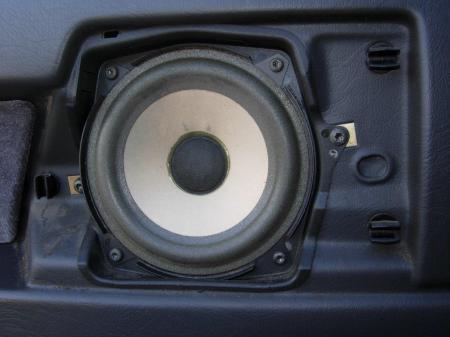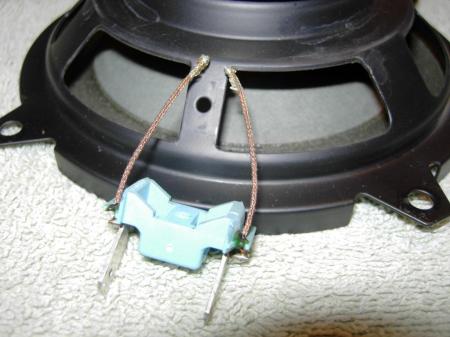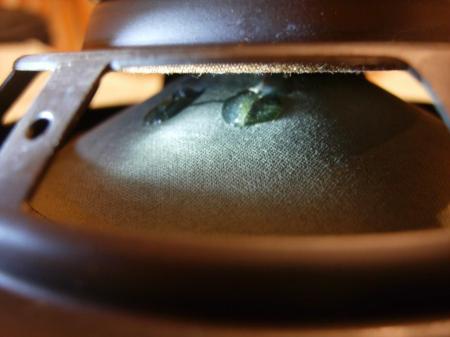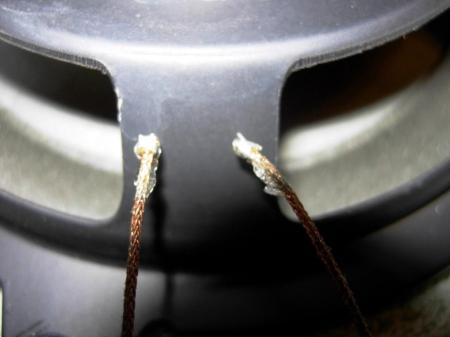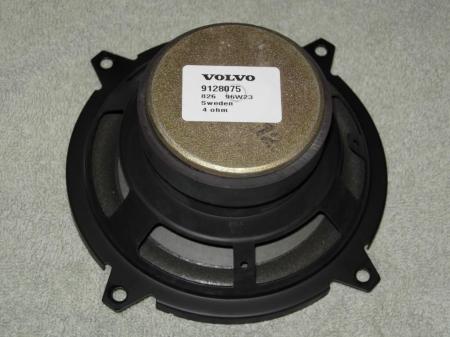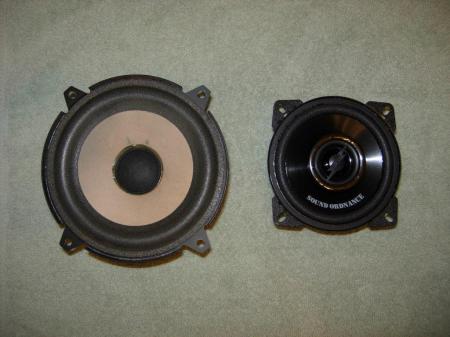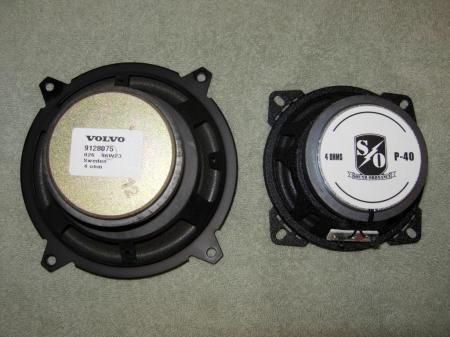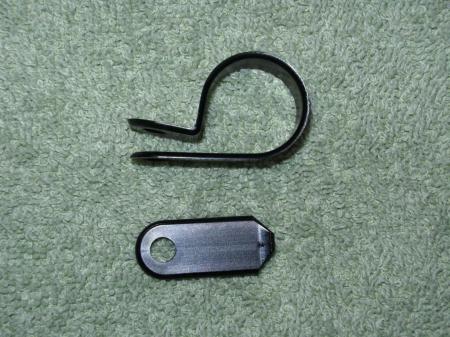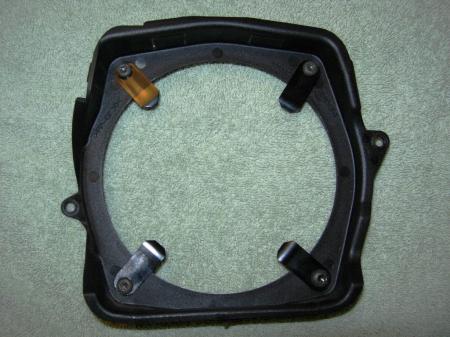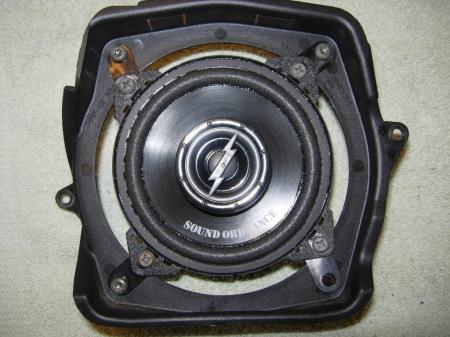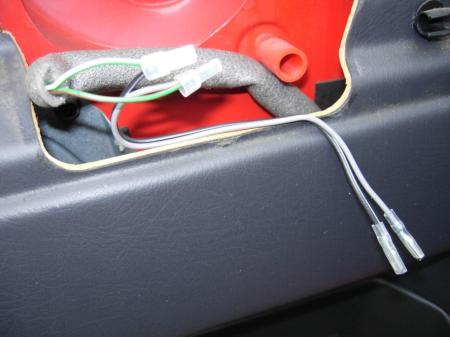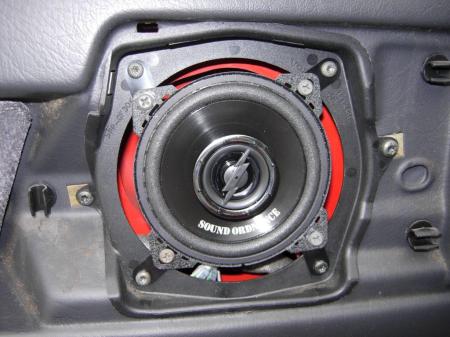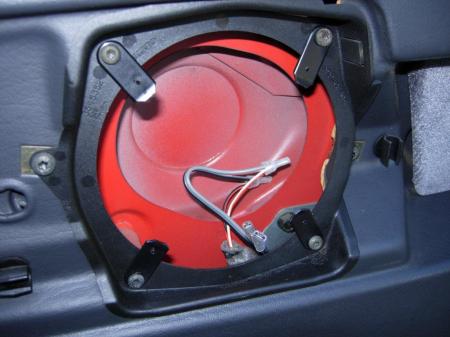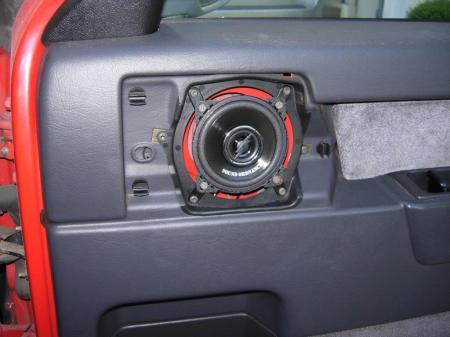Since I had been driving this car to work recently, I noticed all sorts of little things that need attention. My commute is at least a half hour so I listen to the radio quite a bit. The speaker in the driver’s door was dead and that became quite obvious in a hurry. It seemed like I lost hearing in my left ear because there was little sound from the radio on that side. This was confirmed by playing with the L-R balance control and F-R fader to localize the dead loudspeaker.
So I investigated to see if it was the speaker or the wiring that was misbehaving. Can’t be the amplifier since I get sound from three other speakers on the left side.
Removed the driver side speaker by prying off the grill and then unscrewing the speaker.
While attempting to disconnect the wires from the speaker, the blue terminal block popped off and two wires with it.
It’s hard to get access but I measured resistance across the voice coil wires with a multimeter and found them to read around 4Ω as expected, meaning the speaker coil is OK.
In this design the voice coil wires are soldered to the flexible terminal wires and glued to the speaker cone. While this arrangement may be common, I believe it is a poor design because the mechanically fragile solder joint is constantly vibrating and will probably fail over time. I surmise that one of the joints failed and came loose which is why the speaker stopped working. The other one may have been weak and popped off easily when the terminal block broke away.
It is nearly impossible to re-solder these flex wires to the voice coil because of a small opening and very short leads. And a factory speaker from a salvage car is likely to suffer from the same problem. So a new speaker is in order. Factory speakers are rather expensive so I decided to get a decent quality low-cost after-market replacement. To sound the same on both left and right sides, these speakers should be replaced in pairs, which is how they are usually sold anyway.
Main specifications are 4Ω impedance and 4 inch (100mm) diameter. Power rating is not critical with the factory amplifier which is relatively weak. There are many different ways a person could replace these but the following is how I chose to do it.
At Crutchfield I found what seem to be decent speakers at a very good sale price ($20 per pair). Customer reviews are generally favorable and most people report a big improvement over factory speakers on most cars. Looking at the one that came out of the car I don’t think they are particularly good; seem to be very cheap and basic. I didn’t want to put much money into these speakers (people often do spend a lot for speakers) but at this price I thought I’d take a chance.
These new speakers are actually coaxial with a tiny tweeter over the woofer (mid/bass) cone. On the 850 the front tweeters are up in the dash pad where the highs reflect off the windshield. So these coaxial replacements will add some highs to the front. This helps because I also tore one of the tweeter cones when working on the dash earlier so it isn’t performing well anyway.
Crutchfield’s replacements are slightly smaller. The speaker cone is 3-1/4″ compared to the factory 4″. The package seems much smaller because the original speaker had a wider metal frame and surround (the flexible part connecting the cone to the frame).
Because it’s smaller, the mounting holes are about 1″ further in, meaning I had to adapt the mounting. It’s much easier to work on this outside the car so I removed the speaker frame from the door.
For mounting adapters I used plastic cable clamps and cut the loop off, then screwed these strips into the bracket. The lower right screw fastens directly to the door so I just used a screw to loosely locate this adapter.
With four adapter strips fabricated and installed I marked where the new speaker holes should be and drilled a small starter hole. Then used short self-tapping screws to bite into the plastic adapters.
I was concerned that these thin plastic strips might not be strong and secure enough but they held together very well even when I pulled on the speaker. I’m confident this adaption scheme will last a long time.
The new speakers have different sized disconnect terminals so I had to cut the original connectors off and splice in to the wiring adapters provided with the speakers.
Now I could install the speaker frame back into the door and secure that fourth (lower right) adapter strip.
Ready for audio check and it worked very well; sounds clear and loud and has a lot more high-frequency response with the coaxial tweeter built in. Not audiophile grade speakers but to me they sound slightly better than the original speaker.
Snapped the cover back over the speaker and we’re ready to do the same for the right (US passenger) side speaker. Even though that speaker still works, it should be replaced to match sound quality.
Other people might want to upgrade their sound system in the same situation or just get higher-quality speakers. I was more interested in being cheap but keeping sound at least as good as factory speakers.
Update 4/10/14: When I replaced the passenger (US right) side speaker, I tried doing the work in the car without removing the speaker frame from the door. Turns out this works fine and a little less work.
$20 for an inexpensive but decent set of coaxial speakers.
